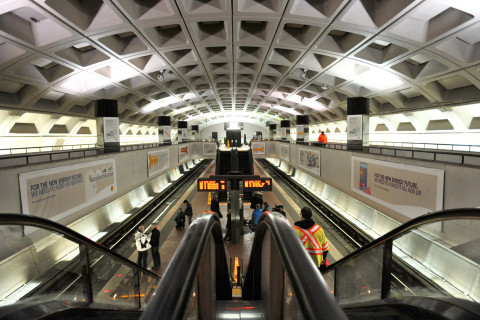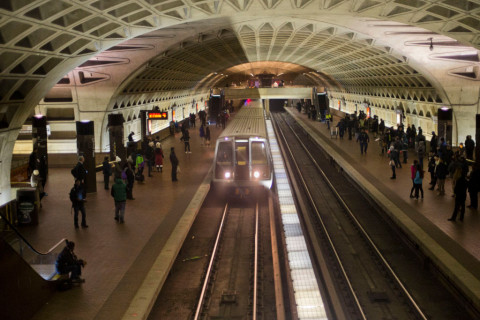WASHINGTON — After a series of communications failures resulted in two fed-up Red Line riders exiting a stopped train last week, Metro officials Thursday discussed solutions ranging from better testing equipment to equipping train operators with bullhorns to communicate with passengers in an emergency.
The train was stopped in a tunnel just north of Farragut North for 18 minutes when a rider opened a door on the seventh car of the new 7000-series train. A second person decided to get off the train a few minutes later.
The signal was red because of a switch issue tied to single-tracking that could have been avoided if the control center had followed proper procedure during the setup of the work zone.
The train had lost communication with the Rail Operations Control Center, which acts as the rail systems air traffic control.
The Metro Board of Directors Safety Committee learned Thursday that third-rail power remained on even after Metro workers knew a rider had exited the train.
“By procedure and rule, the power should have been removed and a walkaround of the train should have occurred,” Chief Safety Officer Pat Lavin said. “That did not happen.”
Lavin said a loose wire on the new train’s radio rendered it useless, and there may be additional issues with radio coverage in the area that could be remedied with additional antenna.
Metro said it’s now testing all underground pocket tracks for the possible issue.
The train operator was carrying his handheld radio, which is now being checked, but was out of touch for at least four minutes while the train was stopped.
Thirty-two minutes later, the train was finally brought back to Farragut North.
Should train operators be equipped with bullhorns?
Robert Lauby, the Federal Railroad Administration’s chief safety officer, who sits on the board, raised separate communication issues about unintelligible announcements in most Metro cars.
While Lauby assumed Metro tested key equipment like radios before trains went into service, Lavin said that is not always the case.
“I don’t think it’s really clearly defined what the test is supposed to be,” Lavin said.
Metro plans to implement a new policy that would require testing both handheld radios and built-in radios.
General Manager Paul Wiedefeld said other potential new initiatives include adding bullhorns as standard equipment in train cabs and looking into whether announcements to train passengers can be made directly from the control center.
Wiedefeld hopes the bullhorns could be used as a backup for the public address system and by train operators who need to move from one end of the train to the other to turn the train around.
Wiedefeld also said Thursday he has asked for an outside review of the troubled Rail Operatons Control Center by experts from other American transit agencies.
Major problems with the control center that go back years, and were tied by federal investigators to the deadly smoke incident near L’Enfant Plaza. One controller said the right hand did not know what the left hand was doing.
Wiedefeld: ‘You cannot take that risk’
Regardless, Wiedefeld said there is no reason for riders to decide to go into tunnels on their own.
“No one should ever get off the train in any condition unless directed,” he said. “If you sit on the tarmac for three hours, you don’t open the door and take the slide down and get on the tarmac. You cannot take that risk.”
It can be difficult to safely walk down the catwalk to a station or emergency exit, he said. The raised walkway is relatively narrow and has equipment boxes and other obstructions jutting out from the tunnel walls.
“We cannot train customers how to walk on that … It is a very dangerous position to put yourself in, so that is not acceptable,” Wiedefeld said.
At the location where the Red Line riders got off the train, there is no continuous catwalk to the station platform since the train was on a middle track.
Wiedefeld defended track workers who left third rail power on with riders walking on or along the tracks.
“At the moment what they did was safe to get them out of the track,” Wiedefeld said.
Evans: ‘I would lead the charge to get off’
Despite Wiedefeld’s admonitions, Metro Board Chair Jack Evans said he can understand why riders would choose to put themselves at risk by leaving the train, even if it is a bad idea.
“If I was stuck on a Metro train for 10 minutes and nobody told me what was going on, I would lead the charge to get off … because I don’t know what’s happening. So I think it’s Metro’s responsibility to inform our riders what’s happening immediately,” Evans told reporters.
“There’s blame to go around,” he added. “I guess … at the end of the day we’re responsible for that because we put people in a situation where they feel they have no other options,” he said.
Evans emphasizes that it is not a good idea to exit the train unless directed.
“We would just encourage people to stay on the trains because of the danger involved,” he said.
But he doubled down on what his own instincts might be, even as a relatively infrequent rider.
“If I’m stuck on a train, and I’m not getting told anything and 10-15 minutes goes by and in the back of my mind is, you know, is this thing going to fill up with smoke? What’s going to happen here? Nobody’s telling be what to do, yeah, then my personality would be, yeah, I’d kick the door open and get off. But I hope that other people don’t have that personality and they actually stay on the train, but more importantly I hope that Metro takes it upon itself to inform customers about what’s happening here, our riders, so that they don’t panic and kick the door off and get off,” he said.
Evans said the board and Metro staff must improve communication with riders.
“It’s almost a comic situation if it weren’t so sad,” he said.
‘Breakdown in communication’
Wiedefeld could not say whether the train operator involved in this incident is operating trains today, and declined to say whether there had been anyone disciplined over the incident, citing the ongoing investigation.
“Clearly there was a breakdown in communication,” Wiedefeld said. “Our operators are to communicate what’s going on to let people know what’s going on, for whatever reason that did not occur.”
Even without radio communication for a few minutes, the general manager said the operator could have told riders they were stopped at a red signal.
Instead, the train played automated announcements telling riders they would be moving momentarily.
“There wasn’t an emergency, it was just he was sitting there waiting, so people got frustrated,” Wiedefeld said. “I get that.”
We’ve (not) heard this before
Metro riders have long complained about a lack of communication, even in more benign situations, and Metro Board Member Kathy Porter of Takoma Park asked Metro leaders whether that would really change.
“A consistent problem that we have had, every time there has been some incident where passengers have been trapped on a train or they have self-evacuated, we consistently have a problem with communications,” she said.
“And each time this happens, we recognize communications are a problem, and the next time it happens communications are still a problem,” she added. “And this is an issue that comes up over and over again and we don’t seem to know how to address it.”
Porter said the fact that riders even consider getting off the train on their own is a communication failure, since they do not appear to understand that the risks include death if the third rail is energized.
“People’s reactions are often self-defeating in terms of things like self-evacuation, but we really can’t expect people to act the way that we want them to act unless we give them the information that they need to act upon,” she said.
“We can’t just say, ‘Oops, someone self-evacuated’ when a whole train car full of people has been sitting there for almost 20 minutes without getting sufficient information.”
Riders have expressed similar concerns about a lack of information while waiting to move through track work zones or stuck because of other issues, such as a passenger’s medical emergency.
“I don’t know what to say at this point. We seem to be very good at dealing with infrastructure and engineering type problems. We don’t seem to be very good at dealing with communications issues at all,” Porter said.
However, the board separately heard findings Thursday from a review of Metro’s power systems that identified a series of significant issues including workers who do not have the proper skills or do not get proper training, possible design flaws in key infrastructure, and communications issues within the agency.
Federal investigators reached similar conclusions this summer about a lack of training and ability among Metro track inspectors and maintenance workers.






